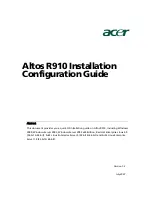
Installing a memory module
The following notes describe the types of dual inline memory modules (DIMMs) that
the server supports and other information that you must consider when you install
DIMMs (see “System-board optional-device connectors” on page 17 for the location
of the DIMM connectors):
v
The server supports industry-standard, 1066 or 1333 MHz, PC3-10600-999
(single-rank or dual-rank) double-data-rate 3 (DDR3), unbuffered, synchronous
dynamic random-access memory (SDRAM) dual inline memory modules (DIMMs)
with error correcting code (ECC). For a list of supported options for the server,
see http://www.ibm.com/servers/eserver/serverproven/compat/us/; then, select
your country and navigate to the list of options for the server.
v
The maximum amount of memory that the server supports is dependent on the
type of memory that you install in the server. See “Unbuffered DIMMs (UDIMMs)”
on page 29 for more information.
v
The amount of usable memory is reduced, depending on the system
configuration. A certain amount of memory must be reserved for system
resources. To view the total amount of installed memory and the amount of
configured memory, run the Setup utility. For additional information, see “Using
the Setup utility” on page 53.
v
The maximum memory speed is determined by the combination of the
microprocessor, DIMM speed, and the number of DIMMs installed in each
channel.
v
You can use compatible DIMMs from various manufacturers in the same pair.
v
When you install or remove DIMMs, the server configuration information
changes. When you restart the server, the system displays a message that
indicates that the memory configuration has changed.
v
The specifications of a DDR3 DIMM are on a label on the DIMM, in the following
format.
ggg e
Rx
ff
-PC3-
wwwwwm
-
aa
-
bb
-
cc
where:
ggg
is the total capacity of the DIMM (for example, 1GB, 2GB, or 4GB)
e
is the number of ranks
1 = single-rank
2 = dual-rank
4 = quad-rank
ff
is the device organization (bit width)
4 = x4 organization (4 DQ lines per SDRAM)
8 = x8 organization
16 = x16 organization
wwwww
is the DIMM bandwidth, in MBps
8500 = 8.53 GBps (PC3-1066 SDRAMs, 8-byte primary data bus)
10600 = 10.66 GBps (PC3-1333 SDRAMs, 8-byte primary data bus)
m
is the DIMM type
E = Unbuffered DIMM (UDIMM) with ECC (x72-bit module data bus)
R = Registered DIMM (RDIMM)
U = Unbuffered DIMM with no ECC (x64-bit primary data bus)
aa
is the CAS latency, in clocks at maximum operating frequency
bb
is the JEDEC SPD Revision Encoding and Additions level
28
System x3100 M3 Type 4253: Installation and User’s Guide
Summary of Contents for System x3100 M3
Page 1: ...System x3100 M3 Type 4253 Installation and User s Guide...
Page 2: ......
Page 3: ...System x3100 M3 Type 4253 Installation and User s Guide...
Page 16: ...xiv System x3100 M3 Type 4253 Installation and User s Guide...
Page 30: ...14 System x3100 M3 Type 4253 Installation and User s Guide...
Page 68: ...52 System x3100 M3 Type 4253 Installation and User s Guide...
Page 88: ...72 System x3100 M3 Type 4253 Installation and User s Guide...
Page 93: ......
Page 94: ...Part Number 81Y5864 Printed in USA 1P P N 81Y5864...
















































